Iannis Xenakis, the Greek-French experimental composer and protege designer for the famous architect Le Corbusier, advanced theories of the vertical “Cosmic” city as the only sustainable way forward. Here, he wrote this essay in 1966, decrying decentralization (read: suburban sprawl) in favor of building up, up, up…5 million inhabitants to be housed in a single megastructure, a hyperbolic paraboloid of more than 3,000 meters high and 50 meters wide.
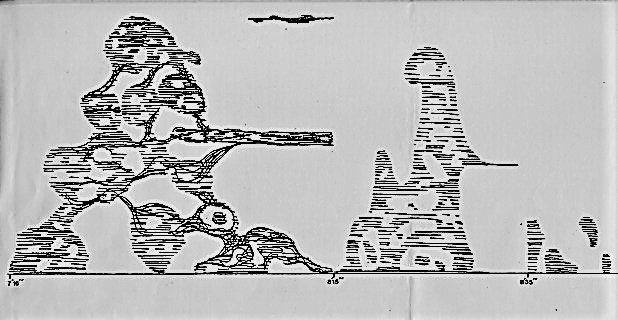

The Cosmic City
By Iannis Xenakis, translated from the French by John Ashbery, Published in The Brooklyn Rail
Faced with the drastic urban and architectural situation of today, we are obliged to lay down axiomatic foundations and to attempt a formalization of the two “sciences.” This is why the first question is that of urban decentralization.
It has been customary for a number of years to speak of the decentralization of the major urban centers, of the dispersal of the industrial centers over the whole of the nation’s territory insofar as possible. This tendency has been transformed into governmental policies that favor economically the transferring of industries and the construction of housing, and not only of large and small industries but also administrative centers and universities. The obsession with decentralization is, one may say, universal, in France as well as in Japan, in the United States, etc. That is to say, in all the countries whose urban concentrations are gigantic. Moreover, in a few generations the “demographic thrust” will render the situation of the cities of the future impossible and deadly, if the urbanists and the governments do not change their traditional mentalities and points of view, rooted in the past and henceforth ineffectual. The solution given to the question of decentralization will determine the shape of any urbanism as well as of architecture.
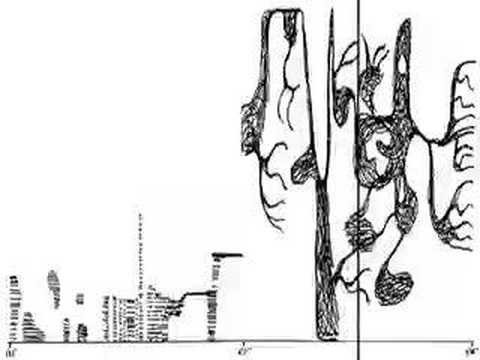
Watch this video on YouTube
Iannis Xenakis, Mycenae-Alpha (1978), audio recording and video – Composed on the UPIC graphic computer system at the Centre d’Etudes de Mathematique et Automatique Musicales in Paris, it is a mono tape manipulated between two or among four speakers. By taking the shapes and movements of natural phenomena, such as molecules in a gas, Xenakis developed a method of digitally mapping those images into the computer and using them to trigger sound events of similar aural shapes. Mycenae Alpha is a composition of dense and intense textures, of phase-shifting waveforms rich in harmonics that cascade, flutter, crash, and scream like sirens in a vast cosmological territory.
Must one then decide in favor of decentralization or on the contrary accept centralization?
First of all, if we place ourselves in the role of observers of contemporary history, it is clear that we are witnessing the development of a powerful force, blind and irreversible, which creates urban concentrations despite all the joint efforts of governments, a force which augments the density and the area of cities. It even seems that a simple but terrible law might be deduced from this simple observation: The major centers grow faster than the small ones, in a logarithmic curve.
Next, if we place ourselves in the socio-cultural perspective of exchanges as well as in that of technology and economy, we see that the large centers favor expansion and “progress” of all kinds. It is a historical conclusion that has been arrived at for thousands of years but continually forgotten, whose equivalent could be found in other domains, for example in complex biological cultures or merely in the abstraction of phenomena of masses, which, in following the law of high numbers, render possible the advent of exceptional and rare events which would be highly improbable (= impossible) in smaller populations. On the other hand, decentralization leads to a dispersal of centers, to an augmentation of the length of routes and of the duration of exchanges, to an airtight specialization of collectivities and to socio-cultural stagnation. The university cities prove this, as do the workers’ cities and all kinds of “cities” within a country, thus invalidating the theories of linear cities and similar naive notions.
These reasons and conclusions are in the air and simple to observe even for those who do not have the leisure to consult or learn to read the statistics of specialized services.
STORY: Iannis Xenakis: Musical Sorcery Using Mathematical Totems
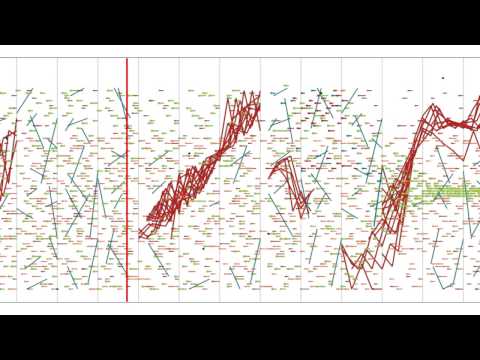
Watch this video on YouTube
Xenakis’ 1955–6 composition, Pithoprakta, reveals not only a mathematician and musician but an amateur physicist and naturalist as well. Recording: Arturo Tamayo, Luxembourg Philharmonic Orchestra, Timpani recordings, 2008. Graphical score: Pierre Carré.
But in that case, why decentralize?
In reality this policy stems from two principal tendencies:
- the suffocation of present-day cities beneath the mass of anarchical communications and the poor distribution of activities over the national territory;
- a tradition and mental inhibition of geometrization and planning of urban entities which, having sprung up again with new vigor in the nineteenth century, became fixed and rooted during the 1920s under the influence of cubism and constructivism.
This second tendency has already shown that it was powerless to resolve the simplest problems, such as the construction of new cities, even when the urbanists have the total cooperation of governments as was the case with Le Havre, Brasilia, and Chandigarh, which for the moment are stillborn cities. In fact it is impossible under the present educational conditions of urbanists and architects (a conservative, oversimple education) for these individuals to resolve a priori on paper the birth, composition, and development of a city which is one thousand times more complex than the problem of a dwelling or a housing unit, problems which are themselves solved haphazardly. This deficiency results in urbanist situations on paper being limited to barren combinations of straight lines and rectangles corrected by incongruously curved spaces (= “green areas”). It is in fact this same deficiency which causes those who have the responsibility of parceling out the territory to be led astray by the biological complexity of a city emerging from the centuries, such as Paris, and who, weary of breathing gasoline fumes and of endlessly waiting in all kinds of lines, preach the explosion of this living complex encroaching on the green desert, rather than attacking, for example, the real problems of the automotive industry, to say nothing of the solutions given by the so-called avant-garde urbanist architects which are in fact nothing but short-sighted and cringing naiveties, since the impossible decentralization-panacea-for-all-urban-ills has not been for them a point of conscience.
Thus, under the tyrannical yoke of these two forces, one real, the other mental, we proceed to decentralize on paper, creating satellite cities (= modern slum cities), dormitory cities, or specialized cities equipped with an absurd architecture (shoe boxes or rabbit warrens), standardized sometimes with a grotesque decorative affectation (Stockholm, for example), or sometimes without (Paris or Berlin).
It is also true that the algorithm of the plane, the right angle, and the straight line, issuing directly from the depths of the millenniums and which is the basis of contemporary architecture and urbanism, has been strongly consolidated by the “new” materials: concrete (because of wooden molds), steel, and glass, as well as by the relatively simple theory of plane and especially linear elements.
But if concentration is a vital necessity for humanity, the present ideas of urbanism and architecture must be changed completely and replaced by others.
On the formal level, the Cosmic City can be considered a manifesto of volumetric architecture, a concept developed by Xenakis as an alternative to the modernist paradigm of the straight line and the right angle, considered obsolete and even obstructive by him. The idea to realize architecture “where no two sections are the same” is taken here to a monumental scale. — Sven Sterken
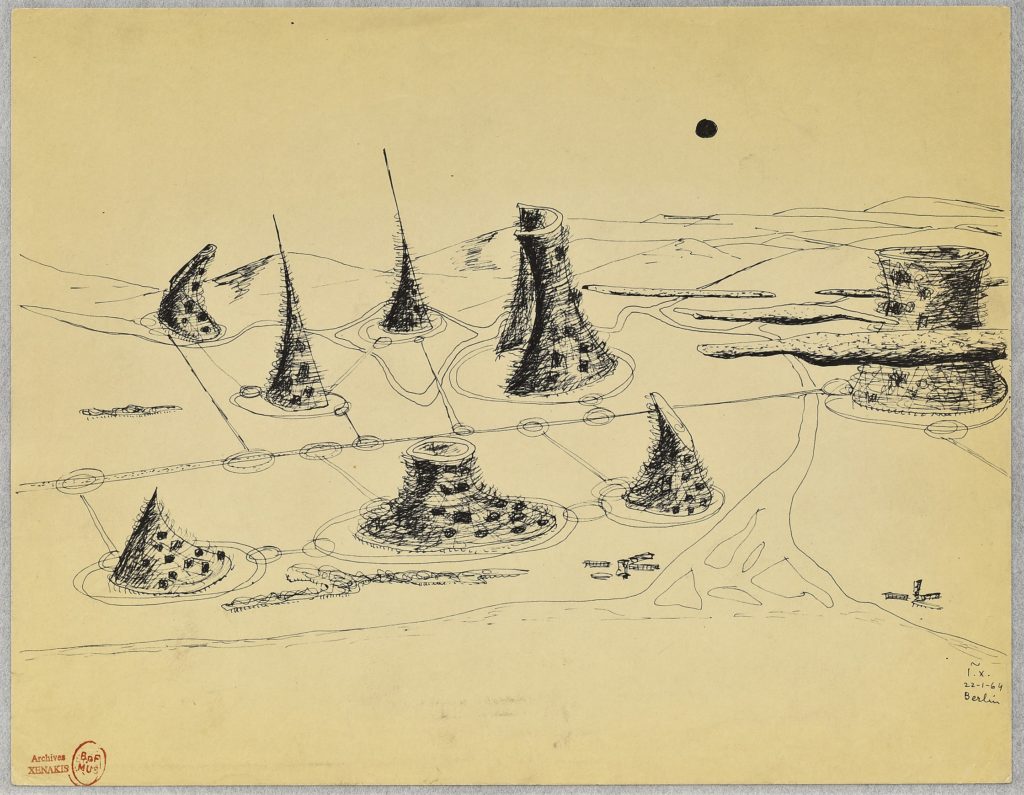

I shall outline a group of ideas which lead to the conception of the vertical Cosmic City.
Here is a list of axiomatic and implied propositions which will perhaps help us to imagine its face and formalize its structure:
- The absolute necessity of promoting vast concentrations of population for the general reasons listed above.
- The high concentration and the enormous technical effort needed imply total independence with regard to the surface of the Earth and the landscape. This leads to the conception of the vertical city which can attain heights of several thousand meters. This independence leads in turn to a giant standardization in which the formalizations of theoretical conceptions and their putting into practice will be necessary and alone effective.
- The shape which the city is to take will have to eliminate the stresses of anti-economic flexion and torsion from its structure.
- Daylight and a direct view of and over space are to penetrate everywhere. Hence a relatively negligible thickness in the vertical city.
- Since the city will be vertical, its occupation of the ground will be minimal. The liberation of the ground and the technical advances of such a city will result in the recovery of vast stretches of land and an automatic and scientific cultivation of the soil utilizing electronic means of management and decision, for the classic peasant with his manual toil is destined to disappear.
- At the outset, the distribution of collectivities will have to constitute a statistically perfect mélange contrary to every present conception of urbanism. There will be no specialized subcity of any kind. The mixing process will have to be total and calculated stochastically by specialized bureaus of the population. Young people and workers will live in the same sector as old people or government officials, for the mutual good of all categories. The living heterogenization of the city will happen by itself later on.
- Consequently, the internal architecture of the Cosmic City will have to be oriented toward conceptions of interchangeable locales (cf. traditional Japanese architecture), adapting itself to the most varied uses, with internal nomadism (movements of populations) becoming more widespread after a certain level of progress. Mobile architecture will thus be the fundamental characteristic of this city.
- Since this city will be fashioned by universal technology, it will be suited to lodging the populations of the far north (or south) as well as those of the tropics or the deserts. Climatic conditioners will thus equip certain of its sections so as to render hundreds of millions of human beings independent of climatic and meteorological contingencies, so that they may attain temperate living and working conditions at any latitude. Thus, its entirely industrialized and formalized technology will transform it into the veritable biological collective garment, receptacle, and tool of its population.
- Communication will be effected by means of cylindrical coordinates with the advantage of great vertical speeds of from 100 to 200 kilometers per hour.
- Communications through the transport of materials (men or goods) are to be accomplished by new techniques—for example, moving sidewalks or streets at slow, medium, or high speeds; vertical or horizontal pneumatic express travel for passengers, etc. Hence, suppression of all types of individual locomotion on wheels.
- Three-dimensional transportation (by air) will be favorized by airfields at the summit of the Cosmic Cities (hence a considerable saving in fuel). The lost time between city and airport will be eliminated.
- The great height of the city will have the advantage (in addition to the very high density it will be able to achieve—from 2,500 to 3,000 inhabitants per hectare) of rising above the most frequent clouds, those moving between 2,000 and 3,000 meters, and of putting the populations in contact with the vast spaces of the sky and the stars, for the planetary and cosmic era has begun and the city must no longer be earthbound but oriented toward the cosmos and its human colonies.
- The transformation of industrial and domestic waste in a closed circuit will take on vast proportions to the benefit of health and the economy.
- By definition, the Cosmic City will not fear the devastations of war since disarmament will have been accomplished on Earth, and outlets and other expansions will be sought in cosmic space, the present nations having transformed themselves into provinces of a giant World State.
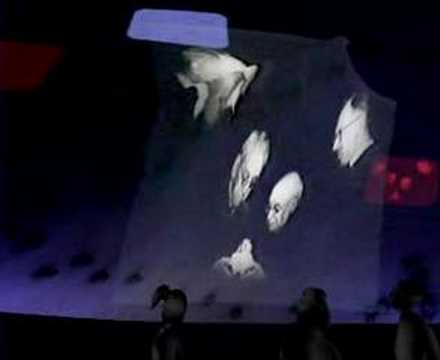
Watch this video on YouTube
Poème électronique at Expo 1958 in Brussels – the conception of the multimedia project by Xenakis, Le Corbusier, and Varèse.
Rapid summary of technical data of the Cosmic City:
The preceding fourteen points require technical solutions that utilize shell structures and in particular warped surfaces such as hyperbolic paraboloids or revolving hyperboloids which avoid efforts of Sexion and torsion and (except at the margins) allow only for cutting stresses of compression.
The form and structure of the city will thus be a hollow shell with a double partition, crisscrossed because of the ruled surfaces employed, having the additional advantage of using linear elements which will always be cheaper.
The 5,000-meter altitude is at the limit of normal pressure and oxygenation which a man can endure without any special apparatus and without previous adaptation. Which is to say that the Cosmic City can “leap” this barrier and grow taller than 5,000 meters on condition that artificial pressurization, humidification, and oxygenation are provided.
If we admit of a diameter at the base equal to five kilometers, the surface of the dome will be approximately 60 km2. This approximate calculation is based on a cone truncated at a height of five kilometers and of bases of 0.5 and 2.5 km. Since the thickness of the shell supporting the city is 50 meters, the volume of the shell will be approximately 3 km3. Now, a city like Paris (which serves as our model), with a density of 500 inhabitants per hectare, forms a layer of a thickness of 22m2, and 5,000,000 inhabitants occupy on the average, with their houses, their public buildings, their industries, and their parks and traffic areas, a volume of 2.2 km3 or a total of 10,000 hectares.
That is to say an average weight of 400 kilograms per square meter of Soor (= ultralight materials, plastic or metal, of very slight volume, thanks to the spatial industries which will thus and outlets on Earth); seven stories. 400 kg/m2 = 2800 kg/m2 for the three-quarters of the city’s hectares, the remaining fourth being formed by streets and green areas. Consequently the total weight of the city will be of (3/4) 10,000 hectares 2800kg/m2 = 210,000,000 metric tons to be distributed over a circular ring on the ground 250 meters wide and with a perimeter of 16 kilometers, with a pressure on the ground of 5 kg/mm2.
Here then is an aspect of an agglomeration, like the one stretching from Washington to Boston, with several tens of millions of inhabitants lodged in the shells of the cosmic cities, situated on a plain between the sea and mountains.
- In fact, for a density of 500 inhabitants per hectare (2.47 acres), a city of five million inhabitants like Paris covers around 10,000 hectares. The city we propose will cover around eight hectares of ground, or less than a thousandth of this space. (Xenakis)
- The curse of modern cities, inflicted by the complex and multiple automotive industries. This is one of the examples of pointless economic and social cancerization, difficult to stamp out in free-enterprise nations. (Xenakis)

Watch this video on YouTube
Poème électronique is an 8-minute piece of electronic music by composer Edgard Varèse, written for the Philips Pavilion at the 1958 Brussels World’s Fair.
This essay first appeared in Art and Literature 10 (Autumn 1966).
Excerpted from Collected French Translations: Prose by John Ashbery, out now from Farrar, Straus and Giroux. Copyright © 2013 by John Ashbery.
CONTRIBUTORS
Iannis Xenakis (1922–2001) was a composer, music theorist and architect-engineer. He fled Greece in 1947 and became a citizen of France. Along with Stockhausen, he is regarded as one of the most important post-war avant-garde composers. He integrated music with architecture and designed spaces to be integrated with his compositions and performances.
John Ashbery has published more than 30 collections of poetry, and he is a prolific French translator.
Updated 20 February 2021

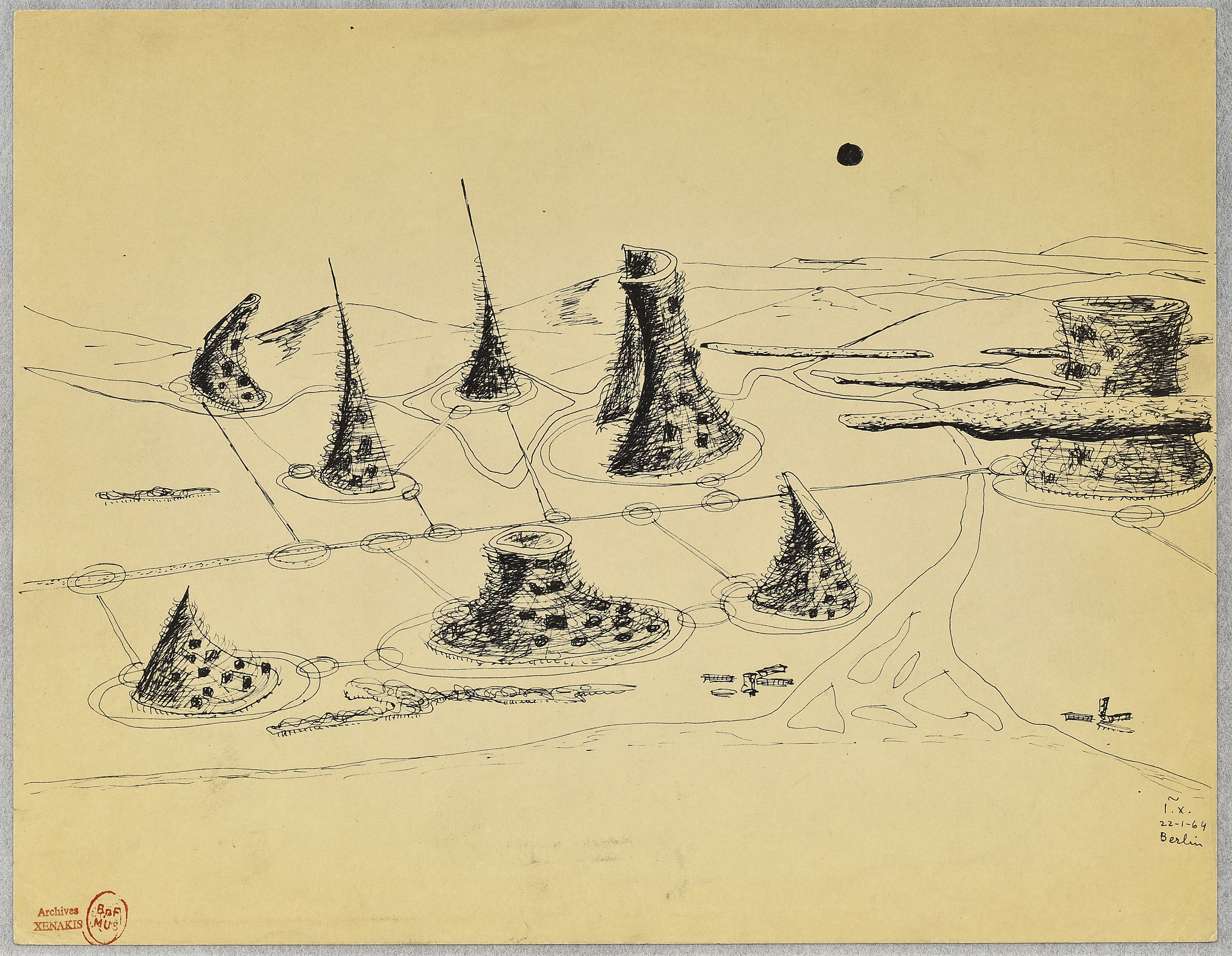












Pingback: Urban Utopia or Dystopia? The 15-Minute City Debate - WilderUtopia